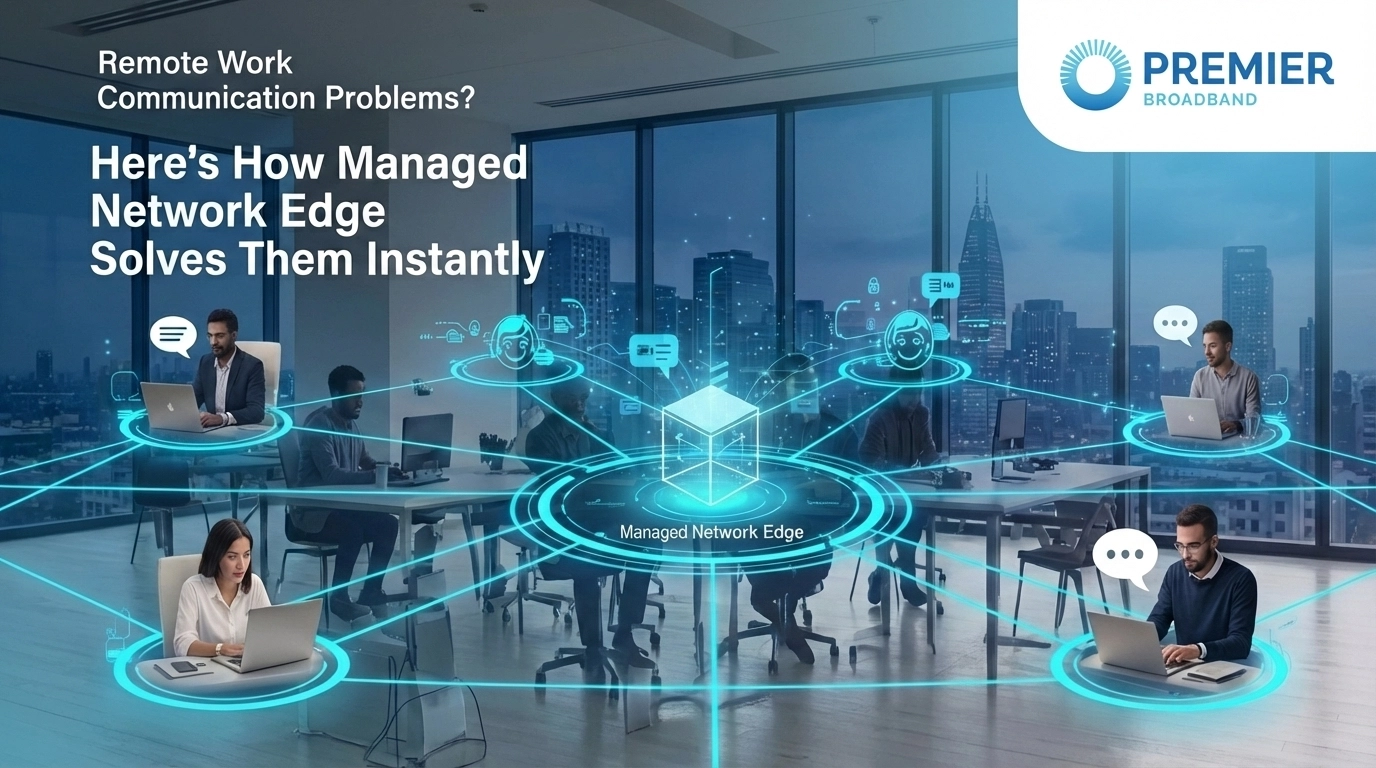When it comes to internet for your business, the best providers are typically those offering dedicated fiber, high-speed cable, or managed SD-WAN solutions. Each one shines in different situations. For instance, fiber is the top choice for speed and reliability if your company moves a lot of data, while cable is a great, cost-effective option for smaller teams. For businesses with multiple locations, SD-WAN is the way to go for centralized management and security.
Comparing the Top Business Internet Options
Choosing the right internet service is a critical decision that affects everything from your team's productivity to your customers' happiness. Business internet isn't like your home plan; it's all about guaranteed performance, uptime backed by a Service Level Agreement (SLA), and features built for commercial use. Getting familiar with the main connection types is the first step to finding a provider that fits your operational needs and your budget.
You'll mainly run into three categories: fiber, cable, and managed solutions like SD-WAN. Each technology has its own strengths. Fiber is the gold standard for pure speed and rock-solid reliability, cable offers wide availability and good value, and managed services give you enhanced security and control over complex networks.
Comparing Top Business Internet Options
This table breaks down the main internet categories by speed, reliability, and the type of business they're best suited for. It's a quick way to narrow down what's right for you.
| Provider Category | Typical Speed Range | SLA Uptime Guarantee | Ideal Business Profile |
|---|---|---|---|
| Fiber Optic | 100 Mbps – 10 Gbps | 99.99% or higher | Data-heavy industries, cloud-native companies, and firms needing symmetrical speeds. |
| Cable Internet | 50 Mbps – 1 Gbps | 99.9% | Small to medium-sized businesses, retail locations, and budget-conscious operations. |
| Managed SD-WAN | Varies by connection | Customizable | Multi-site organizations, businesses with remote workers, and companies prioritizing security. |
As you can see, each option is tailored for different business needs.

The main takeaway here is that there's no single "best" choice. It all depends on what your business prioritizes—whether that's raw performance, keeping costs down, or having tight control over your network.
Key Criteria for Selecting a Business Internet Provider
Choosing a business internet provider isn't just about chasing the fastest advertised speeds. The right connection is a core business asset that directly impacts your team’s productivity, your customer experience, and your day-to-day stability. Before you sign a contract, you need to understand what really defines a quality connection.
A rock-solid connection is the foundation of any modern business. That’s why the global broadband market is projected to skyrocket past $1,289.67 billion by 2034. Businesses are the main engine behind this growth, making up roughly 45% of the market share in 2024 as we lean more heavily on cloud apps, video calls, and connected devices.

Speed, Symmetry, and Performance
While download speed gets all the glory in ads, upload speed is often what makes or breaks a business's daily operations. Things like video conferences, cloud backups, and sending large files all rely on a strong upload pipeline. This is where symmetrical speeds—where your upload and download speeds match—really shine, especially with fiber optic connections.
Cable internet often provides asymmetrical speeds, prioritizing downloads. That can quickly create a bottleneck for teams that are constantly collaborating online. You can learn more about this in our guide on https://premierbroadband.com/what-is-a-good-upload-speed/.
Another piece of the puzzle is latency, which is the small delay it takes for data to travel back and forth. Even with blazing-fast download speeds, high latency can cause that annoying lag on video calls. For real-time tools like VoIP phones or live streaming, low latency is an absolute must.
Key Insight: A connection with symmetrical speeds and low latency is often far more valuable to a business using cloud apps and real-time communication than a plan with a higher, but lopsided, download speed.
Reliability and Service Guarantees
Consistent uptime is everything. You need your connection to just work. A provider’s reliability is officially promised through a Service Level Agreement (SLA), which is the key document that separates a real business-grade service from a residential one.
An SLA is a contract that guarantees a provider's performance, usually promising 99.9% or even 99.99% uptime. It also spells out other critical details:
- Guaranteed response times for when you need tech support.
- Performance metrics like latency and packet loss limits.
- Compensation or credits if the provider fails to deliver on their promises.
Without a solid SLA, you’re left with no guarantees during an outage. Make sure you read it carefully before signing anything.
Scalability and Future-Proofing
Your internet shouldn't just fit your business today; it needs to be able to grow with you tomorrow. Scalability is all about how easily a provider can upgrade your bandwidth or add services as your company expands.
A truly scalable provider lets you adjust your plan without causing major downtime or forcing you into complicated contract hassles. This flexibility ensures your internet can keep up as you hire more people, open new locations, or adopt new technologies. Choosing a provider with a robust fiber network is a great way to future-proof your investment.
Of course, beyond the provider, there are always other strategies to improve your business internet speed to get the most out of your connection.
A Head-to-Head Look at Fiber, Cable, Wireless, and SD-WAN
Choosing the right internet connection for your business involves real trade-offs. Fiber, cable, fixed wireless, and SD-WAN are all fantastic options, but each one shines in different situations depending on what you value most—be it raw speed, unshakable reliability, or network-wide control.
Let's break down how these four technologies stack up against the criteria that matter: symmetry, SLA guarantees, latency, and scalability. This comparison will help you pinpoint the best fit for your team’s unique demands.
| Tech | Top Speed | Symmetry | Best Use Case |
|---|---|---|---|
| Fiber | Up to 10 Gbps | Yes | Data-heavy, cloud-native teams |
| Cable | Up to 1 Gbps | No | Small offices, tight budgets |
| Fixed Wireless | Up to 1 Gbps | Often No | Remote sites, rapid backup |
| SD-WAN | Aggregate Links | Depends | Multi-location network control |
Uptime You Can Count On
When your connection is your business, uptime is everything. Here’s what you can typically expect from a Service Level Agreement (SLA):
- Fiber: 99.99%
- Cable: 99.9%
- Fixed Wireless: 99.95%
- SD-WAN: Customizable SLAs
Fiber optic is the clear winner for businesses that can't afford bottlenecks. Its perfectly matched upload and download speeds mean cloud backups, video calls, and large file transfers just work—smoothly and without a hitch.
Cable internet is everywhere and offers great download speeds for a very reasonable price. But the catch is its asymmetrical design, which can slow down teams that are constantly uploading content or collaborating in the cloud.
Real-World Fiber Versus Cable
So, what does this look like in practice? Let's get down to the brass tacks.
- Your Speed Needs: Fiber is built for multi-gigabit performance, easily handling anything you throw at it. Cable, on the other hand, usually maxes out around 1 Gbps.
- Your Budget: Cable plans often come in about 20–30% cheaper for every megabit you get.
- Getting Set Up: In many suburban areas, getting a cable connection installed is a quicker process.
- Your Reliability Demands: Fiber SLAs promise an impressive 99.99% uptime, a noticeable step up from cable’s 99.9% guarantee.
Fixed wireless is a game-changer for locations where digging trenches for fiber or cable isn't practical. It uses radio links to deliver solid connectivity, making it perfect for remote branch offices or as a bulletproof backup if your main line ever goes down.
SD-WAN is a different beast altogether. It acts as a smart layer on top of your existing connections, blending fiber, cable, LTE, and wireless into one cohesive, managed network. It automatically routes traffic to ensure your most important applications always get the performance and security they need.
"By abstracting each underlying link, SD-WAN enhances uptime, applies QoS, and simplifies security across sites."
— Network Architect, Premier Broadband
For a closer look at why fiber has the edge, check out our guide on why fiber internet is superior to cable internet.
The global market for internet services is booming. It was valued at $592.37 billion in 2021 and is projected to hit $711.11 billion by 2025. North America is a major player, holding 31.29% of the market and expected to grow from $188.37 billion to $222.52 billion—an 18.1% jump.
Making the Right Choice
As you weigh your options, keep these key factors front and center:
- Do you need symmetrical speeds for cloud apps and VoIP?
- How critical are SLA uptime guarantees and fast support?
- Are real-time applications sensitive to latency?
- Will your connection need to scale as you grow?
- What’s the right balance between cost and performance for you?
- What's actually available in your area and how fast can it be installed?
If your business absolutely depends on maximum reliability and identical upload/download speeds, it might be worth exploring a dedicated business leased line to understand all the high-performance options available.
Which Technology Is Best for Your Business?
Let’s simplify it. Here’s a quick cheat sheet:
- Data-intensive single site: Go with Fiber and a rock-solid SLA.
- Budget-sensitive small office: Cable provides great download performance for the price.
- Remote site or backup connection: Fixed wireless offers a fast and flexible solution.
- Multi-site enterprise: SD-WAN is your key to centralized, intelligent network management.
The best approach is to match the technology to your daily operations and budget. Once you've narrowed it down, check for local availability and negotiate terms that lock in the performance and pricing you need to succeed.
A Side-by-Side Evaluation of Provider Technologies
When you're looking at the best business internet providers, you need a clear, honest look at how each technology actually performs when it matters most. To help you cut through the marketing fluff, we've put together a straightforward scoring system. It rates each core internet technology against the criteria that really impact your daily operations.
This isn't just about the advertised speeds. We're giving you a practical, side-by-side comparison. By scoring fiber, cable, fixed wireless, and managed SD-WAN on things like performance consistency, symmetrical speeds, and SLA guarantees, you can see exactly where each one shines and where it might fall short.
Provider Technology Scored Against Key Business Needs
Let's translate the tech specs into real business value. The table below uses a simple 1-10 scoring system (with 10 being the best) to rate each technology across six crucial areas. This approach makes it easy to see which solution lines up with your company’s top priorities, whether that's pure speed, guaranteed uptime, or just being budget-friendly.
After the table, we'll break down what these numbers mean for your business in the real world.
| Provider Category | Speed Score | Symmetry Score | SLA Score | Latency Score | Security Score | Price Score |
|---|---|---|---|---|---|---|
| Fiber Optic | 10/10 | 10/10 | 9/10 | 10/10 | 8/10 | 7/10 |
| Cable Internet | 7/10 | 4/10 | 6/10 | 7/10 | 6/10 | 9/10 |
| Fixed Wireless | 8/10 | 7/10 | 8/10 | 8/10 | 7/10 | 8/10 |
| Managed SD-WAN | 9/10 | 9/10 | 10/10 | 9/10 | 10/10 | 6/10 |
This chart quickly shows how fiber, cable, and wireless providers stack up on the most important business metrics.

As you can see, fiber sets the bar for performance, while cable comes in strong on the value front.
What These Scores Mean For Your Business
A high score in one column might be a game-changer for your business, but totally irrelevant for another. For instance, a video production company uploading huge files will live and die by a perfect Symmetry Score. On the other hand, a small retail shop might care a lot more about the Price Score. Let’s dig into the details.
Fiber Optic (Average Score: 9.0)
Fiber absolutely earns its top marks, scoring perfectly in speed, symmetry, and latency. Its dedicated, light-based connection delivers performance you can count on, making it the gold standard for any business that relies heavily on cloud apps, VoIP calls, or big data transfers. The upfront cost can be higher and it’s not available everywhere, but for data-heavy companies, the benefits are impossible to ignore.
Cable Internet (Average Score: 6.5)
Cable’s biggest selling point is its fantastic Price Score, giving you fast download speeds without breaking the bank. But its low Symmetry Score is a major drawback, as the slow upload speeds can create a serious bottleneck for backing up files or using video conferencing. Since it’s a shared network, the SLA Score is lower because performance can dip when everyone in your area is online.
Taking a Closer Look at Wireless and Managed Options
Looking beyond the usual wired connections, fixed wireless and SD-WAN bring some unique advantages to the table. They’re great for solving specific challenges, like getting solid internet to a remote office or managing a complex network across multiple locations.
Fixed Wireless (Average Score: 7.7)
Fixed wireless is a really solid choice, scoring well in every category. It’s a dependable alternative in places where fiber or cable aren't an option, delivering impressive speeds and pretty low latency. Its SLA Score is often better than cable because it can be a dedicated connection, which makes it a fantastic option for either your main service or as a failover backup.
Managed SD-WAN (Average Score: 8.8)
SD-WAN is in a class of its own, and its high scores for control and reliability show why. It doesn't create an internet connection—it intelligently manages multiple connections you already have (like fiber and LTE). That's why it gets a perfect SLA Score and Security Score; it provides automatic backup if one connection goes down and gives you centralized security across your entire network. The initial investment is higher, but for any business with more than one location, the value is huge.
The biggest difference in business internet isn't just speed—it's the guarantee. A solid SLA with managed support means that when something goes wrong, you have a partner who is contractually required to fix it fast. That’s the kind of peace of mind that protects your revenue and your reputation.
The internet service provider industry is massive, with around 16,870 companies competing worldwide in 2025 in a market expected to reach $966.6 billion. All that competition is great for innovation, but it also means you have to look past the flashy ads and focus on providers that deliver performance you can actually count on. You can discover more insights on the global ISP market trends here.
Ultimately, picking the right provider means matching a technology’s strengths to what your business truly needs. Use these scores to start the conversation and figure out which solution will not only keep you running today but also set you up for future growth.
Matching The Right Internet Service To Your Business

Finding the perfect internet plan isn’t about picking the fastest headline speed. It’s about how that connection behaves under your team’s daily demands. Rather than abstract specs, let’s walk through four concrete business scenarios and land on recommendations you can act on right away.
By zooming in on real-world workflows—from a boutique design studio bombarded with giant files to a healthcare practice where downtime isn’t an option—you’ll see exactly which service fits each situation.
Case Study 1: The Small Creative Agency
A 15-person creative team lives and breathes the cloud. They juggle high-res video edits, 3D renders, and huge graphics packages. Fast downloads are fine, but their slow uploads turn a 30-minute video export into a multi-hour slog.
The Core Challenge
Their asymmetrical cable plan leaves uploads starving for bandwidth. When a quick client preview becomes a half-day wait, productivity grinds to a halt.
The Ideal Solution: Symmetrical Fiber Optic Internet
A 1 Gbps fiber link with equal upload and download speeds transforms their day:
- Large File Transfers: What once took hours now completes in minutes.
- Video Conferencing: Crystal-clear client reviews, even mid-upload.
- Cloud Collaboration: Instant co-editing of design files, fueling creative momentum.
Implementation Insight: Insist on a Service Level Agreement guaranteeing 99.99% uptime. Every minute down equates to lost billable hours.
Case Study 2: The Growing Tech Startup
Imagine a 50-person SaaS company. All development, support and VoIP calls run in the cloud. Their worst nightmare? An outage that yanks down customer apps and halts internal builds.
The Core Challenge
They rely on a single high-speed line with zero redundancy. A cut fiber or hardware failure means total shutdown—and a tarnished reputation.
The Ideal Solution: Managed SD-WAN With Diverse Connectivity
Pair a primary fiber circuit with a secondary fixed wireless link. Let SD-WAN handle the rest:
- Automatic Failover: Traffic seamlessly shifts if the main line drops.
- Quality Of Service (QoS): Prioritizes VoIP and production servers, even under load.
- Easy Scalability: Add bandwidth or new sites without ripping up the network.
By exploring bundled packages, small businesses can often find cost-effective options. Premier Broadband offers a range of internet and phone services for small business that can be tailored to specific growth needs.
Case Study 3: The Multi-Location Retail Business
A retail chain spans 25 stores, each processing POS transactions and tapping into a central inventory system. VoIP at every register means voice traffic is just as critical as data. Yet each store uses a different ISP—speed and reliability vary wildly.
The Core Challenge
Inconsistent networks lead to blind spots, security gaps, and a constant stream of support tickets.
The Ideal Solution: Managed Network Edge With Standardized Connections
Deploy the same primary service (cable or fiber) and an LTE/5G backup at each site:
- Centralized Management: One dashboard for health, performance and security.
- Unified Security: A single policy protects POS data everywhere.
- Predictable Performance: Every location hits the same uptime and speed targets.
Case Study 4: The Healthcare Clinic
A mid-sized clinic handles sensitive patient records via a cloud-based EHR and relies on VoIP for appointment calls. Security, reliability and compliance aren’t nice-to-haves—they’re mandatory.
The Core Challenge
Even a few minutes offline risks patient care. Shared broadband simply doesn’t cut it.
The Ideal Solution: Dedicated Fiber With a Robust SLA And Security Services
A private, uncontended fiber line delivers unwavering performance:
- Guaranteed Uptime: Look for an SLA with 99.99% availability and credits for any lapses.
- Managed Security: Firewalls, threat detection and compliance support safeguard patient data.
- Symmetrical Speeds: Essential for telehealth video sessions and rapid upload of imaging files.
Each of these scenarios highlights how context drives the decision. By matching your business profile to the right connectivity mix, you’ll avoid costly surprises and keep operations running smoothly.
Frequently Asked Questions About Business Internet
We get asked a lot of questions about business internet. Here are a few of the most common ones we hear, along with straightforward answers to help you make the best choice.
How Much Bandwidth Do I Really Need?
It really comes down to what your team does all day.
If video conferencing is a big part of your operations, you'll want to budget at least 2 Mbps for every person on a call. For a 20-person team juggling different tasks, a 75–150 Mbps plan is a solid starting point.
- Simple email and web browsing are light work and can get by with 10–30 Mbps.
- For heavy file sharing and backups, you'll feel the difference with upload speeds of 10 Mbps or more.
- Cloud apps run best on symmetrical plans, where upload and download speeds are equal, preventing annoying bottlenecks.
What Do SLAs Actually Guarantee?
Service Level Agreements (SLAs) are all about uptime guarantees and how fast a provider promises to respond when things go wrong.
A 99.9% SLA sounds great, but it still allows for up to 8.76 hours of downtime a year. The real story is often in the response time clauses, which dictate how quickly they’ll start fixing a problem.
- For VoIP, latency needs to stay under 150 ms to avoid choppy calls.
- Packet loss should be guaranteed under 1% to keep conversations clear.
- Always check what happens if they don't meet the guarantee—look for service credits as compensation.
How Can I Switch Providers Without Causing a Headache?
A smooth transition is all about planning.
Try to schedule the switch during your slowest hours to minimize any disruption. A pro tip is to keep your old internet connection running until you’ve fully tested and signed off on the new one. It's a small step that can save you from major issues.
| Question | Key Consideration |
|---|---|
| Bandwidth | Match your plan to your busiest times and future growth. |
| SLA | Compare both the uptime promise and the response time clauses. |
| Transition | Keep both connections active until the new one is fully tested. |
Will my current hardware work with the new service? It's crucial to confirm that your routers and switches are compatible.
Key Insight: A good provider will walk you through all the equipment requirements upfront, so you don't get hit with unexpected setup costs.
What’s a typical contract length? Most providers offer terms from 12 to 36 months. Watch out for early termination fees, which can be steep—sometimes as much as 2 times your monthly bill.
- Does the SLA include financial credits if they fail to deliver?
- How long does an installation usually take?
- Is managed support included, or is it an extra cost?
The best way to avoid hidden charges is to read the fine print. Look for one-time fees, equipment rentals, and any other surcharges.
What About Security and Phone Quality?
Look for a provider that offers built-in security features like a firewall and DDoS protection.
- Ask about their encryption standards and if they have intrusion detection.
- If you handle sensitive data, verify they can support compliance for HIPAA or PCI.
Will VoIP calls sound bad on my new internet? Not if you prioritize Quality of Service (QoS) settings for voice traffic. Make sure your provider offers VoIP compatibility checks to prevent issues like jitter and lag before they start.
- Confirm they support common codecs like G.711 for crisp, clear calls.
- Ask if they offer managed voice services or SIP trunking to simplify your setup.
How Do I Know If Service Is Available in My Area?
Most provider websites have a tool where you can enter your ZIP code to check for coverage.
Availability for fiber and wireless can vary block by block, so it's always best to confirm serviceability and installation times before you sign anything. These questions help clear up the confusion and make sure your internet investment truly supports your business goals.
Can My Internet Plan Grow With My Business?
Your internet should be an asset, not a roadblock. Make sure the plan you choose can scale up easily as your business expands.
Get started with Premier Broadband




